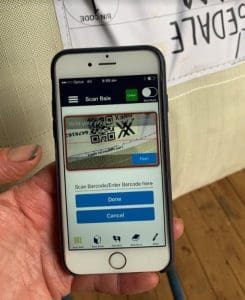
AWH is encouraging wider use of electronic specis in the wool industry. Image – AWH.
AUSTRALIA’S biggest wool handler is encouraging wider use of electronic clip specification tools, estimating errors made using a paper-based system cost the industry about $1 million dollars annually.
AWH is Australia’s largest wool and independent cotton handler, handling and preparing more than 50 percent of the national wool clip offered at auction.
The company estimates the cost of bale weight adjustments, misdescriptions, duplications, unreadable identification marks, changes, validation and checking costs the Australian wool industry close to $1,000,000 a year.
“No-one sees that, it’s a hidden cost and it drives us crazy in wasted time and expense,” AWH national wool manager David Mitchell said.
AWH believes it can be reasonably expected that wool clips prepared and administered by electronic wool classer specification formats would be processed for auction faster and with less preparation costs, than those which are prepared using traditional paper based formats.
“Our people are really liking them (the e-specis) and are seeing a lot less issues with them, especially with the mulesing status side of things.”
Mr Mitchell said the company is seeing a dramatic reduction in the number of errors by wool classers and growers who are using electronic wool classer specification tools. AWH can incorporate data from either of the electronic speci products available to the industry, which include the AWEX WoolClip app and WoolQ’s eSpeci.
“It’s early days and we are only receiving a small percentage of wool classer specifications prepared using electronic tools; however, we can clearly see a significant reduction in errors associated with receiving and preparing wool for sale.
“In addition, we are seeing the National Wool Declaration completed more clearly, which on many occasions when completed using a paper wool classers specification is open to interpretation by the broker receiving the wool classers specification.”
AWH is supporting and strongly encouraging all wool classers and wool growers to adopt the new electronic wool classer specification formats.
“Our biggest bugbear for 100 years has been the inaccuracy of information that has been written down as opposed to what is physically received.
“We are not seeing many of these electronic specis and we are receiving them in a hard format, we are not in a position to receive them electronically at the moment.
“But what are receiving in a hard copy is significantly improved over what we have seen in a hand-written form,” he said.
Mr Mitchell said about 60-70 percent of AWH’s receival issues are comprised of overweight bales and the others are misdescriptions.
WoolClip use is growing

The mobile phone WoolClip app is a key part of AWEX’s proposed eBale system.
WoolClip™ is an online internet and smartphone app that allows the user to create wool Specifications and National Wool Declarations. AWEX said it uses a simple, intuitive workflow designed to reduce workload and errors.
AWEX chief executive officer Mark Grave said in the 2019/20 season to date more than 41,000 bales have been created on WoolClip and the apps use was growing.
“The response has been very good and those that use it (grower/classer/broker) tend to continue to use it.
“The feedback we have received from brokers is the electronic specification is a vast improvement on the hand written specification for accuracy and ease of use, the layout in the pdf/printed version is excellent and the completion of the NWD is a bonus,” he said.
“Between 5000–7000 bales are being created each month (on WoolClip).”
The WoolClip modules include ‘Team’ to manage access, a mob book, the NWD, wool book and a clip specification. A smartphone app can be used where there is no phone signal or data connectivity.
Once finalised, WoolClip will send the specification by email to the nominated marketing organisation as well as to owner/managers and marketing representatives. The specification data is also released for the destination warehouses to download at their discretion and import into their systems. The WoolClip website is found here: www.woolclip.com.au
WoolQ gathering momentum – AWI
Australian Wool Innovation describes its WoolQ eSpeci as an intuitive and easy-to-use ‘app’ that captures in-shed wool data electronically. The eSpeci works when users have an internet connection, or in sheds when there is no connection, and ‘syncs’ easily when online access is available, AWI said.
The WoolQ eSpeci tool was launched in 2015 as an alternative to the current paper speci and allows wool growers and wool classers to accurately and efficiently capture their in-shed clip data at the time of shearing. By recording this data electronically, AWI said the eSpeci would reduce errors, enable easier sharing of documentation and a central source of information from multiple users.
Once the eSpeci is complete, it can be sent electronically to the broker or shared with any other contact for visibility, traceability and collaboration. AWI said the eSpeci has been trialled successfully across multiple working shearing sheds in New South Wales and Victoria.
AWI’s general manager for the eastern hemisphere John Roberts said WoolQ continues to gather momentum and more growers and classers are starting to understand the benefits of the WoolQ Especi as adoption numbers expand.
“Positive feedback on increased efficiencies through reduced error rate is being reported within the domestic supply chain which is a great outcome and just a sign of things to come as WoolQ adoption increases and its full potential is realised.
“Proactive users of the WoolQ Especi have suggested they see further upside with increased sharing of data, within the industry more generally, which will only enrich the traceability journey and enrich the Australian Wool Story to the global consumer in the longer term.”
WoolQ platform is now established and being actively used by numerous stakeholder groups. This includes more than 2100 grower registrations, 680 industry profiles, and 230 registered brands using the Especi with the details of 20,000 bales entered.
Mr Roberts said those using the WoolQ Especi included 54 classers, 30 brokers and 52 exporters.
AWH is co-owned by the international stevedore and global logistics company DP World Australia and the world’s largest agri-business company Nutrien Ag Solutions.

HAVE YOUR SAY